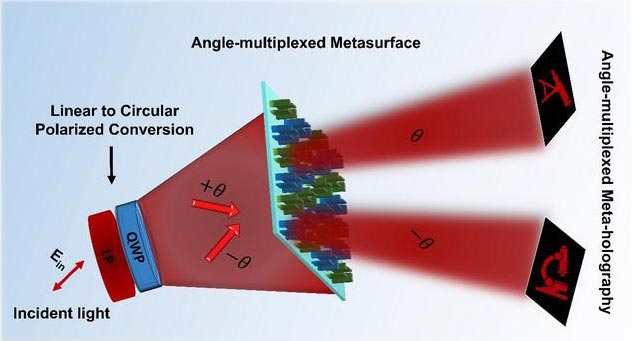Angle-dependent holograms made possible by metasurfaces

Versatile meta-holographic display featuring different images based on viewing angle
Credit: POSTECH
The expression “flawless from every angle” is commonly used to characterize a celebrity’s appearance. This doesn’t simply imply that they appear attractive from a specific viewpoint, but rather that their appeal remains consistent and appealing from various angles and perspectives. Recently, a research team from Pohang University of Science and Technology (POSTECH) has employed metasurface to fabricate angle-dependent holograms with multiple functions, capturing significant interest within the academic community.
A research team comprising Professor Junsuk Rho from the Department of Mechanical Engineering and the Department of Chemical Engineering and PhD candidate Joohoon Kim from the Department of Mechanical Engineering at the POSTECH created metasurface display technology. This technology allows holograms to display multiple images based on the observer’s viewing angle. The findings were recently published in Nano Letters, an international journal focusing on nanoscale research and applications.
Objects can appear distinct depending on the viewer’s position, a concept that can be harnessed in holographic technology to generate cinematic and realistic 3D holograms presenting different images based on the viewing angle. However, the current challenge lies in controlling light dispersion according to the angle, making the application of nano-optics in this context a complex endeavor.
The team addressed this challenge by leveraging metasurfaces, artificial nanostructures capable of precisely manipulating the characteristics of light. These metasurfaces are incredibly thin and lightweight, approximately one-hundredth the thickness of a human hair, making them promising for applications in miniaturized displays such as virtual and augmented reality devices. Through the use of metasurfaces, the team devised a system that controls light to convey only a specific phase of information at a given angle, resulting in diverse images based on the angle of incidence.
In their experiments, the team’s metasurface generated distinct 3D holographic images at angles of both +35˚ and -35˚ for left-circular polarization. Remarkably, the team achieved the production of different images for incident light by using a single metasurface, contingent on the specific polarization. Notably, the holographic display demonstrated an extensive viewing angle of 70 degrees (±35 degrees), enabling observers to perceive the three-dimensional hologram from various directions.
Professor Junsuk Rho who led the research explained, “We have successfully achieved an effective display from diverse angles.” He added, “We anticipate this technology will make significant contributions to the commercialization of technology in virtual and augmented reality displays, encrypted imaging, information storage, and other applications.”
The study was conducted with the support from the program of POSCO-POSTECH-RIST Convergence Research Center program, the STEAM Research Program of the National Research Foundation of Korea funded by the Ministry of Science and ICT, and the Alchemist fellowship of the Ministry of Trade, Industry and Energy.
Journal: Nano Letters
DOI: 10.1021/acs.nanolett.3c04064
Article Title: Spin-Selective Angular Dispersion Control in Dielectric Metasurfaces for Multichannel Meta-Holographic Displays
Article Publication Date: 2-Jan-2024
Media Contact
Jinyoung Huh
Pohang University of Science & Technology (POSTECH)
jyhuh@postech.ac.kr
Office: 82-54-279-2415
All latest news from the category: Machine Engineering
Machine engineering is one of Germany’s key industries. The importance of this segment has led to the creation of new university degree programs in fields such as production and logistics, process engineering, vehicle/automotive engineering, production engineering and aerospace engineering among others.
innovations-report offers informative reports and articles covering technologies such as automation, motion, power train, energy, conveyor, plastics, lightweight construction, logistics/warehousing, measurement systems, machine tools and control engineering.
Newest articles
Faster, more energy-efficient way to manufacture an industrially important chemical
Zirconium combined with silicon nitride enhances the conversion of propane — present in natural gas — needed to create in-demand plastic, polypropylene. Polypropylene is a common type of plastic found…

Energy planning in Ghana as a role model for the world
Improving the resilience of energy systems in the Global South. What criteria should we use to better plan for resilient energy systems? How do socio-economic, technical and climate change related…

Artificial blood vessels could improve heart bypass outcomes
Artificial blood vessels could improve heart bypass outcomes. 3D-printed blood vessels, which closely mimic the properties of human veins, could transform the treatment of cardiovascular diseases. Strong, flexible, gel-like tubes…





















